
Winter Vanlife on the Canarian Islands
Den ersten Winter haben wir auf den Kanarischen Inseln verbracht. Hier findest du Nützliche Infromationen über die Inseln und unsere persönlichen Highlight der Inseln.

-

First view of Tenerife. The sun sets behind the mountains
The Canary Islands are the perfect place to escape winter without leaving Europe. The seven islands are all unique, each with its own special highlights, making them worth a visit. As we prefer to spend some time in one place, we limited ourselves to Tenerife, Gran Canaria, and Fuerteventura during the three months we were here.
Climate
The Canary Islands are the southernmost point of Europe (if islands are counted) and attract with pleasant winter weather. Average temperatures in winter usually range between 18 and 24 degrees Celsius. It can be warmer during the day, while temperatures may cool down at night, but there are generally no extreme cold spells. The islands have a year-round dry climate, and winter is no exception. In most parts of the islands, there is limited rainfall in winter, and rainy days are rare. The islands are known for sunny weather, and there are many hours of sunshine in winter, making them a popular destination for sun lovers and outdoor activities.
Proximity
Since the Canary Islands belong to Europe, it is particularly easy for Europeans to travel there. No visa is required, and since we traveled by ship from Huelva (Spain), we were not even asked for a passport. However, you should always have your valid passport with you on such a journey.
Good to know: Calima
Calima is a dusty, sandy, and dry desert wind that comes from the Sahara region. Calima can have various effects on the region, such as an increased temperature. During Calima, temperatures can rise significantly as warm, dry air from the Sahara flows into the region. This can lead to unusually high temperatures. However, the biggest problem is the large amount of desert dust and sand suspended in the air. This can significantly impair visibility and lead to poor air quality.
Tips and Tricks for Traveling with a Van in the Canary Islands
Travelers with a van have different requirements than those staying in a hotel room. Therefore, we have summarized our tips here to help you navigate the Canary Islands better.
Water
Public and free drinking water is scarce in the Canary Islands. There are a few public fountains where the water is good, but you can count them on one hand, and we didn’t find any on Fuerteventura. However, water is available everywhere in large containers for purchase.
Inflation
We were lucky and enjoyed the low fuel prices in the winter of 21/22. Unfortunately, that has changed. As far as we have researched, prices have risen sharply, as in Germany. This also applies to groceries, as almost everything has to be imported by ship.
Wild Camping
We never had problems with wild camping throughout our time in the Canary Islands, but we know that it is more challenging on the main island of Gran Canaria than on the “undeveloped” islands. We felt very free on Fuerteventura, where there are many open spaces, and no one complains if you camp there.
As a tip, we would like to recommend the parking lots of Área recreativa. But please be friendly and do not set up tables, chairs, and awnings.
Our Highlights in the Canary Islands
We don’t want to list all the highlights here because there is plenty of inspiration on social media and in current travel guides. However, we would like to highlight a few things:
Ghost Town of Abades (Tenerife)
This place on Tenerife is an extraordinary lost place that differs significantly from the usual abandoned buildings like war bunkers or deserted factories. Instead, it is an abandoned hospital that extends like a whole village. This abandoned medical facility tells a fascinating and mysterious story.
In 1944, the town on Tenerife was built and was originally conceived as a sanatorium for leprosy patients. At that time, almost 200 people in the Canary Islands contracted leprosy, which is why the construction of the Sanatorium de Abona began. However, the hospital was never completed because a successful leprosy medication came onto the market.
A tour of this place is special, also because of the many graffiti that now adorn the remains of the walls.
-

Jo in front of the graffiti of a pufferfish. -
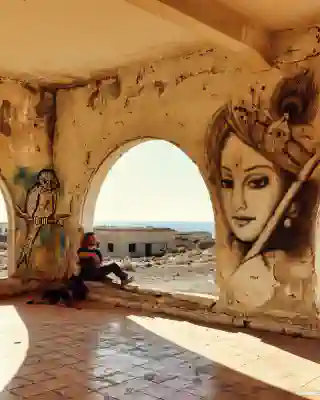
In an arched window sits Georg. -

Image of two eyes on a column. -

In the background is the bell tower of the monastery.
Teide National Park (Tenerife)
The Teide, at 3,715 meters, is the highest point in Spain, higher than the Zugspitze, which we hiked in August 2021. However, we didn’t make it to Pico el Teide, even though we had enough time. Hiking to the summit requires not only good condition but also registration, which should be done well in advance. We were too late for that.
Please note that there is snow at the top in winter. On the weekend we visited the National Park, it would not have been possible for us to hike to the summit as the path was closed due to a snowstorm.
But even so, you should visit the National Park because it is truly an exceptional place. You will find a landscape like the moon and a vastness reminiscent of America.
-
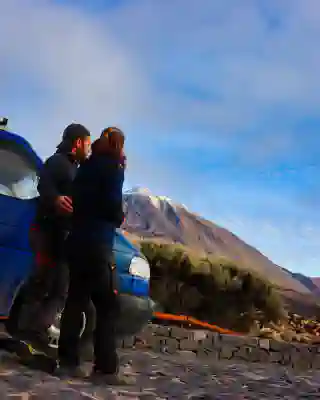
Georg, Jo, and Momo in front of the quest. In the background, the peak of el Teide is visible. -
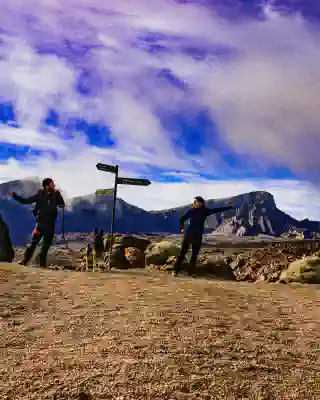
Georg, Jo, and Momo in the Teide National Park at a signpost. Jo points in one direction, and Georg points in the other. -

View from above of the cliff.
Volunteering at Arche Noah (San Isidro, Tenerife)
Our “detour” to the Canary Islands was planned and had a special goal. We wanted to work as volunteers in an animal shelter for a month. You can read all about this time in our article: Volunteering at Arche Noah .
-
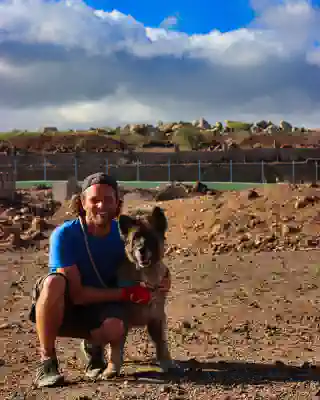
Georg and the German Shepherd Fiona.
Maspalomas (Gran Canaria)
The dunes of Maspalomas are no longer a real secret, and since many hotels surround the dunes, there is hardly a time to truly enjoy the sand dunes alone. If you still want to try, you should set your alarm very early and ideally be there with the sunrise. But remember, there will be others there too.
-

Jo, Georg, Momo, and Nelly on a sand dune. -
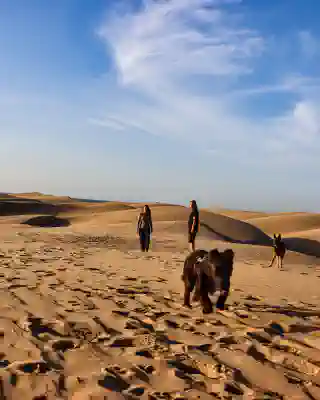
Sand as far as the eye can see.
San Buenaventura Monastery and Betancuria (Fuerteventura)
You should remember this photo spot because it is just perfect. The former monastery has a picturesque atmosphere with its arches and columns! You can also visit the small village where the former monastery is located. There are some nice restaurants with beautiful gardens where you can end the evening.
-

Georg, Jo, Momo, and Nelly in front of a white wall. -

Jo in a half column. -

Jo and Georg between columns. -

Jo on a ledge. In the background, half columns.
El Cotillo and Playa del Castillo (Fuerteventura)
Cotillo is a very small town that we liked. At the beach that runs directly south from the village, you can also camp wild and look out to sea. Surfing is also excellent here, especially for beginners. You can rent surfboards in Cotillo. Also, you should visit El Goloso de Cotillo, a small cafe with many delicious treats.
Cofete
The beach of beaches! Kilometers long, with the mountains of Parque Natural Jandía in the background. We were lucky and were almost alone here. A detour is a must!
Playa de Sotavento de Jandía
And if you like beaches, we have a bonus for you. This beach is more like a lagoon and just so beautiful. We spent our last day here before heading to the mainland, but we also recommend just enjoying your first evening here. It will blow you away.
-

Jumping photo of Georg, Jo at the lagoon. -
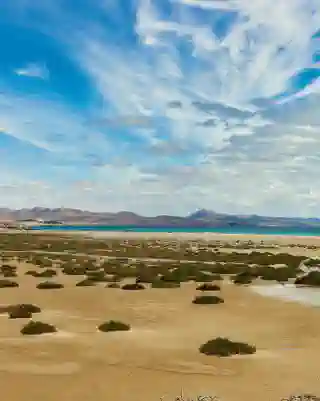
View of the lagoon. -
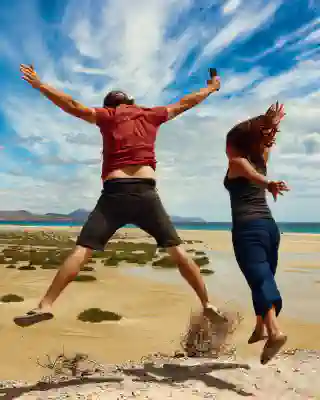
Jumping photo of Georg, Jo at the lagoon. -

Jumping photo of Georg, Jo at the lagoon.